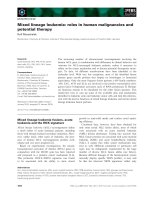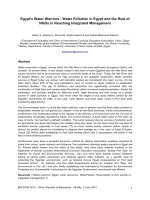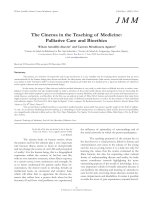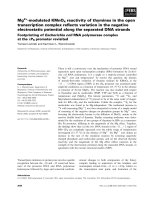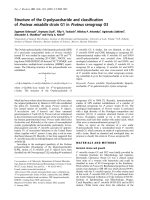POPULAR CINEMA IN EGYPT Walter Armbrust pot
Bạn đang xem bản rút gọn của tài liệu. Xem và tải ngay bản đầy đủ của tài liệu tại đây (183.17 KB, 13 trang )
1
POPULAR CINEMA IN EGYPT
Walter Armbrust
Egyptian cinema makes an intriguing point of entry into the study of popular
cuture. In this two-week segment in the M.St. in Film Aesthetics course students
will consider various analyses of what is at stake in "popular cinema," but in a
context that will compel them to think one step further—not just of how
"popularity" is constructed in European or American cinema, but also how
standards for popularity travel across cultures. The films required for this module
will contrast works that have been considered popular by various criteria, with
films that have in one way or another turned their backs on the quest for
popularity in pursuit of other ends. The objective of this segment of the course is
to throw light on the category of "popular cinema" from an angle that will be
unfamiliar for most students. By doing so we illuminate its contours more
effectively than would be the case if we were to examine popular culture in the
context of the European and American films typically analyzed in film studies
literature.
I will be giving lectures on the history of Egyptian Cinema in St. Antony's College,
the Hilda Bess Building, New Room, Wednesdays from 2-4, Weeks 1, and 3-7.
Week One Screenings:
Determination
(al-'Azima). 1939. Kamal Salim.
I Love You
(Ahibbak Inta). 1949. Ahmad Badr Khan.
Sleepless Nights
(Sahar al-Layali). 2003. Hani Khalifa.
Recommended:
Terrorism and Kabab
(al-Irhab wa al-Kabab). 1992. Sharif
'Arafa.
Session 1: National Cinema
Readings
: Crofts, Stephen. 2006. "Reconceptualizing National
Cinema/s." In Valentina Vitali and Paul Willemen eds.,
Theorising National Cinema
. London: BFI, pp. 44-60.
Crofts, Stephen. 2006. "The National Revisited." In
Valentina Vitali and Paul Willemen eds.,
Theorising
National Cinema
. London: BFI, pp. 29-43.
Rosen, Philip. 2006. "History, Textuality, Nation: Kracauer,
Burch and Some Problems in the Study of National
Cinemas." In Valentina Vitali and Paul Willemen eds.,
Theorising National Cinema
. London: BFI, pp. 17-28.
2
Shafik, Viola. 2006.
Egyptian Popular Cinema: Gender,
Class, and Nation
. Cairo: American University in Cairo
Press. (Introduction, pp. 1-10; Part I: Nation, pp. 11-116).
Session 2: Popular Cinema
Readings
: Adorno, Theodor and Max Horkheimer. 1993. "The Culture
Industry: Enlightenment as Mass Deception." In Simon
During ed,
The Cultural Studies Reader
. London:
Routledge, pp. 31-41.
Armbrust, Walter. 1996.
Mass Culture and Modernism in
Egypt
. Cambridge: University of Cambridge Press.
(particularly chapter 4)
Elsaesser, Thomas. 1981. "Narrative Cinema and
Audience-Oriented Aesthetics." In Tony Bennett, Susan
Boyd-Bowman, Colin Mercer and Janet Woollacott eds.,
Popular Televison and Film
. London: BFI Publishing in
Association with the Open University Press, pp. 270-282.
Hall, Stuart. 1981. "Notes on Deconstructing 'the Popular."
In Raphael Sauel ed.,
People's History and Socialist
Theory
. London, Boston, and Henley: Routledge and
Kegan Paul, pp. 227-40.
Week Two Screenings:
The Mummy
(al-Mumiya`). 1969. Shadi 'Abd al-Salam.
Chatter on the Nile
(Tharthara foq al-Nil). 1971. Husayn
Kamal.
Alexandria Why
(Iskindiriyya Leh?). 1979. Youssef Chahine
Recommended:
The Closed Doors
(al-Abwab al-Mughlaqa). 1999. Atef
Hetata.
Session 3: Un-popular Cinema
Armes, Roy. 1987.
Third World Filmmaking and the West
.
Berkeley: University of California Press. ("Youssef
Chahine," pp. 243-254).
Colla, Elliott. 2000. "Shadi Ab al-Salam's
al-Mumiya'
:
Ambivalence and the Egyptian Nation-State." In Ali
Ahmida ed.,
Beyond Colonialism and Nationalism in the
maghreb
. New York: Palgrave, pp. 109-143.
Discourse: Journal for Theoretical Studies in Media and
Culture
. 1999. v. 21 (1) ("Middle Eastern Films Before
3
Thy Gaze Returns to Thee"; special issue including
translation of script of
The Mummy
)
Fawal, Ibrahim. 2001.
Youssef Chahine
. London: BFI
(particularly Introduction, p. 1-21; ch. 5, Autobiographical
Trilogy, pp. 117-153).
Shohat, Ella and Robert Stam. 1994.
Unthinking
Eurocentrism: Multiculturalism and the Media
. New York:
Routledge. (ch. 4, Tropes of Empire, pp. 137-177; ch. 7,
The Third Worldist Film, pp. 248-292).
Session 4: Cultural Intimacy
Readings
: Armbrust, Walter. 2004. "Egyptian Cinema On Stage and
Off." In Andrew Shryock ed.,
Off Stage/On Display:
Intimacy and Ethnography in the Age of Public Culture
.
Stanford University Press.
Herzfeld, Michael. 1997.
Cultural Intimacy: Social Poetics in
the Nation-State
. New York: Routledge. (ch. 1,
Introducing Cultural Intimacy, pp. 3-28)
Shryock, Andrew. 2004.
Off Stage/On Display: Intimacy
and Ethnography in the Age of Public Culture
. Stanford:
Stanford University Press. (ch. 1, Other Conscious/Self
Aware: First Thoughts on Cultural Intimacy and Mass
Mediation, pp. 3-28)
Further film recommendations:
The Yacoubian Building
('Imarat Yaqubiyan). 2006. Marwan Hamid.
Salama Is Fine
(Salama fi Khayr). 1937. Niyazi Mustafa.
Love is Forbidden
(Mamnu' al-Hubb). 1942. Muhammad Karim.
Alexandria-New York
(Iskindiriyya Nu Yurk). 2004. Youssef Chahine.
Widad
(Widad). 1936. Fritz Kramb and Gamal Madkur.
The Last Lie
(Akhir Kidba). 1950. Ahmad Badr Khan.
Girls of Today
(Banat al-Yaum). 1957. Henri Barakat.
Snake and Ladders
(al-Silim wa al-Ti'ban). 2001. Tariq al-'Aryan.
M Empire
(Imbraturiyat Mim). 1972. Husayn Kamal.
Excuse Us, We're Doing Fine
(Ma'alesh Ihna Binitibahdil). 2005. Sharif Mandur.
A "Cultural" Film
(Film Thaqafi). 2001. Muhammad Amin.
Further Readings
(*** = key readings)
Popular Culture
4
***Adorno, Theodor and Max Horkheimer. 1993. "The Culture
Industry: Enlightenment as Mass Deception." In Simon During
ed,
The Cultural Studies Reader
. London: Routledge, pp. 31-
41.
Altman, Rick. 1987.
The American Film Musical
. Bloomington:
Indian University Press.
Bennett, Tony. 1998. "Popular Culture and the 'turn to Gramsci'."
In John Storey ed,
Cultural Theory and Popular Culture: A
Reader
. Essex: Prentice Hall, pp. 217-224
Bourdieu, Pierre. 1998 [1984]. "Distinction and the Aristocracy of
Culture." In John Storey ed,
Cultural Theory and Popular
Culture: A Reader
. Essex: Prentice Hall, pp. 431-441.
Collins, Jim. 1989.
Uncommon Cultures: Popular Culture and
Post-Modernism
. New York and London: Routledge.
***Dyer, Richard. 1981. "Stars as Signs." In Tony Bennett, Susan
Boyd-Bowman, Colin Mercer and Janet Woollacott eds.,
Popular
Televison and Film
. London: BFI Publishing in Association with
the Open University Press, pp. 236-269.
Dyer, Richard.
Stars
. London: British Film Institute.
***Elsaesser, Thomas. 1981. "Narrative Cinema and Audience-
Oriented Aesthetics." In Tony Bennett, Susan Boyd-Bowman,
Colin Mercer and Janet Woollacott eds.,
Popular Televison and
Film
. London: BFI Publishing in Association with the Open
University Press, pp. 270-282.
Fiske, John. 1989.
Understanding Popular Culture
. London:
Unwin Hyman.
***Hall, Stuart. 1981. "Notes on Deconstructing 'the Popular." In
Raphael Sauel ed.,
People's History and Socialist Theory
.
London, Boston, and Henley: Routledge and Kegan Paul, pp.
227-40.
Hall, Stuart. 1996. "For Allon White: Metaphors of
Transformation." In David Morley and Kuan-Hsing Chen eds.,
Stuart Hall: Critical Dialogues in Cultural Studies
. London and
New York: Routledge, pp. 287-305.
***McDonald, Paul. 1995. "Star Studies." In Joanne Hollows and
Mark Jancovich eds.,
Approaches to Popular Film
. Manchester:
Manchester University Press, pp. 79-98.
Mukerji, Chandra and Michael Schudson. 1991. "Introduction:
Rethinking Popular Culture." In Mukerji and Schudson eds.,
Rethinking Popular Culture: Contemporary Perspectives in
Cultural Studies
. Berkeley: University of California Press, pp.
1-61.
5
Stacey, Jackie. 1994.
Star Gazing: Hollywood Cinema and Female
Spectatorship
. London: Routledge.
Storey, John. 1996.
Cultural Studies and the Study of Popular
Culture
. Edinburgh: Edinburgh University Press.
Strinati, Dominic. 2000.
An Introduction to Studying Popular
Culture
. London: Routledge.
***Twitchell, James. 1992. "Untended Gates: The Triumph of
Vulgarity in an Age of Show Business." In Twitchell's
Carnival
Culture: The Trashing of Taste in America
. New York: Columbia
University Press.
Nationalism
Anderson, Benedict. 1991.
Imagined Communities: Reflections On
the Origin and Spread of Nationalism.
London: Verso.
Appadurai, Arjun. 1996.
Modernity at Large: Cultural Dimensions
of Globalization.
Minneapolis: Universiy of Minnesota Press.
Balakrishnan, Gopal. 1995. "The National Imagination."
New Left
Review
211: 56-69.
Crofts, Stephen. 1993 "Reconceptualizing National Cinema/s."
Quarterly Review of Film and Video.
14 (3): 49-67.
"Concepts of National Cinema." 1998. In John Hill and Pamela
Church Gibson eds.,
The Oxford Guide to Film Studies.
Oxford:
Oxford University Press, pp. 385-394.
Hafez, Sabry. 2006. "The Quest for/Obsession with the National in
Arabic Cinema." In Valentina Vitali and Paul Willemen eds.,
Theorising National Cinema
. London: BFI, pp. 226-254.
Higson, Andrew. 1989. "The Concept of National Cinema."
Screen
30 (4): 36-44.
Vitali, Balentina and Paul Willemen eds. 2006.
Theorising National
Cinema
. London: BFI.
Williams, Alan ed. 2002.
Film and Nationalism
. New Brunswick,
NJ: Rutgers University Press.
Egyptian Cinema
M.St. in Film Aesthetics Readings
***Armbrust, Walter. 2004. "Egyptian Cinema On Stage and Off."
In Andrew Shryock ed.,
Off Stage/On Display: Intimacy and
Ethnography in the Age of Public Culture
. Stanford University
Press.
***Armbrust, Walter. n.d. (manuscript). "Cinema and Television in
the Arab World." In Robert Hefner ed.,
The New Cambridge
6
History of Islam vol. VI (Muslims and Modernity: Culture and
Society since 1800
). Cambridge: Cambridge University Press.
[should be available by HT 2008]
***Shafik, Viola. 2001. "Cinema in Egypt." In Oliver Leaman ed.,
Companion Encyclopedia of Middle Eastern and North African
Film
.
Introduction to Egyptian Cinema
Reading:
Abu Shadi, Ali. 1996. "Genres in Egyptian Cinema." In Alia
Arasoughly ed., tr.
Screens of Life: Critical Film Writing from the
Arab World
, v. 1. Quebec: World Heritage Press, pp. 84-129.
Farid, Samir. 1996. "Periodization of Egyptian Cinema." In Alia
Arasoughly ed., tr.
Screens of Life: Critical Film Writing from the
Arab World
, v. 1. Quebec: World Heritage Press, pp. 1-18.
Flibbert, Andrew. 2007.
Commerce in Culture: States and Markets
in the World Film Trade
. New York: Palgrave Macmillan.
[comparative study of the Egyptian and Mexican film industries].
Shafik, Viola. 2007.
Popular Egyptian Cinema: Gender, Class and
Nation
. Cairo: American University in Cairo Press.
Shafik, Viola. 1998.
Arab Cinema: History and Cultural Identity
.
Cairo: American University in Cairo.
Vitalis, Robert. 2000. "American Ambassador in Technicolor and
Cinemascope: Hollywood and Revolution on the Nile." In Walter
Armbrust ed.,
Mass Mediations: New Approaches to Popular
Culture in the Middle East and Beyond
. Berkeley: University of
California Press, pp. 269-291. [Shorter analysis of Egyptian
industry economics]
7
Additional Readings/Issues (not specifically for MSt in Film Aesthetics)
Singers: Umm Kulthum and Abd al-Wahhab
Reading:
Armbrust, Walter. 1996.
Mass Culture and Modernism
.
Cambridge: Cambridge University Press. (chapter 4 on
Muhammad Abd al-Wahhab; as much of the rest as possible).
Danielson, Virginia. 1997.
The Voice of Egypt: Umm Kulthum,
Arabic Song, and Egyptian Society in the Twentieth Century
.
Chicago: University of Chicago Press. (particularly chapter on
Umm Kulthum's films)
Shafik, Viola.
Arab Cinema
chapter 2 ("Artistic Roots of Arab
Cinema").
Suggested Readings
: Armbrust, Walter. 2001. "Colonizing Popular Culture or
Creating Modernity? Architectural Metaphors and Egyptian
Media." In Jakob Skovgaard-Petersen and Hans Christian
Korsholm Nielson eds.,
Middle Eastern Cities, 1900-1950
.
Aaarhus: Aarhus University Press.
Armbrust, Walter. 1996.
Mass Culture and Modernism in Egypt
.
Cambridge: Cambridge University Press. (chapters 3 and 4 are
relevant to Abd al-Wahhab).
Danielson, Virginia. 1990/91 (Fall/Winter). "Min al-Mashayikh: A
View of Egyptian Musical Tradition."
Asian Music
22 (1): 113-
127.
Danielson, Virginia. 1998. "Performance, Political Identity, and
Memory: Umm Kulthum and Gamal 'Abd al-Nasir." In Sherifa
Zuhur, ed.,
Images of Enchantment: Visual and Performing Arts
of the Middle East
. Cairo: American University in Cairo Press,
pp. 109-122.
Danielson, Virginia. 1987. "The Quran and the Qasidah: Aspects
of the Popularity of the Repertory Sung by Umm Kulthum."
Asian music
19 (1): 26-45.
Danielson, Virginia. 1996.
The Voice of Egypt: Umm Kulthum,
Arabic Song, and Egyptian Society in the Twentieth Century
.
Chicago: University of Chicago Press.
Frischkopf, Michael. 2001. "Tarab ("Enchantment") in the
Mystic Sufi Chant of Egypt." In Sherifa Zuhur, ed.,
Colors of
Enchantment: Theater, Dance, Music, and the Visual Arts of the
Middle East
. Cairo: American University in Cairo Press, pp.
233-269.
Racy, Ali Jihad. 1991. "Creativity and Ambience: An Ecstatic
Feedback Model from Arab Music."
The World of Music
33 (3):
7-28.
Racy, Ali Jihad. 1991. "Historical Worldviews of Early
Ethnomusicologists: An East-West Encounter in Cairo, 1932."
8
In Steven Blum et. al. eds.,
Ethnomusicology and Modern Music
History
. Champagne-Urbana: University of Illinois Press.
Racy, Jihad. 2003.
Making Music in the Arab World: The Culture
and Artistry of Tarab
. Cambridge: Cambridge University Press.
Racy, Ali Jihad. 1977.
Musical Change and Commercial
Recording in Egypt, 1904-1932
. Ph.D. dissertation, University
of Illinois at Urbana-Champaign.
Shannon, Jonathan. 2001.
Among the Jasmine Trees: Music,
Modernity, and the Aesthetics of Authenticity in Contemporary
Syria
. Ph. D. Dissertation, City University of New York.
Music:
Habib Hassan Touma. 1996.
The Music of the Arabs
[sound
recording]. Compiled, recorded and commented by Habib
Hassan Touma. Portland, Or.: Amadeus Press.
CDs and cassette tapes of Umm Kulthum, Abd al-Wahhab, and
many others are widely available.
Films: Al-Warda al-Bayda
(The White Rose). 1933.
Widad
. 1936.
Salama fi Khayr
(Salama is Fine). 1937.
al-Azima
(Determination). 1939.
Mamnu' al-Hubb
(No Love Allowed). 1942.
Gharam wa Intiqam
(Love and Revenge). 1944.
Ghazal al-Banat
(The Flirtation of Girls). 1949.
The Problem of Dance
Reading:
Dougherty, Roberta. 2005. "Dance and the Dancer in Egyptian
Films." In Anthony Shay and Barbara Sellers-Young eds.,
Orientalism, Transnationalism and Harem Fantasy
. Costa Mesa
Cal.: Mazda Publishers, pp. 145-171.
Franken, Marjorie. 1998. "Farida Fahmy and the Dancer's Image
in Egyptian Film." In Sherifa Zuhur, ed.,
Images of
Enchantment: Visual and Performing Arts in the Middle East
.
Cairo: American University in Cairo Press, pp. 265-281.
Nieuwkerk, Karin van. 1998. "Changing Images and Shifting
Identities: Female Performers in Egypt." In Sherifa Zuhur, ed.,
Images of Enchantment: Visual and Performing Arts in the
Middle East
, pp. Cairo: American University in Cairo Press.
Shay, Antony. 2002. "Egypt: Bazaar of Dance." In Antony Shay,
Choreographic Politics: State Folk Dance Companies,
Representation and Power
. Middletown, Conn: Wesleyan
University Press, pp. 126-162.
Shay, Antony and Barbara Sellers-Young. 2005. "Introduction." In
Anthony Shay and Barbara Sellers-Young eds.,
Orientalism,
9
Transnationalism and Harem Fantasy
. Costa Mesa Cal.: Mazda
Publishers, pp. 1-27.
Zuhur, Sherifa. 2001. "Musical Stardom and Male Romance: Farid
al-Atrash." In Sherifa Zuhur ed.,
Colors of Enchantment:
Theater, Dance, Music, and the Visual Arts of the Middle East
.
Cairo: American University in Cairo Press, pp. 270-296.
Suggested Readings
:
Armbrust, Walter. 1996.
Mass Culture and Modernism in
Egypt
. Cambridge: Cambridge University Press (chapter 6, for
background on the filmKhalli Balak min Zuzu ).
Birnbaum, Dee. 1988. "The Unknown Dancer: The Life of a
Folkloric Dancer in Egypt."
Arabesque
14 (4):12-16.0
Dougherty, Roberta L. 2000. "Badi'a Masabni, Artise and
Modernist: The Egyptian Print Media's Carnival of National
Identity." In Walter Armbrust, ed.,Mass Mediations: New
Approaches to Popular Culture in the Middle East and Beyond.
Berkeley: University of California Press.
Dougherty, Robin. 1986. "In the Temple of Dance, Parts. and
II."Arabesque 12 (1): 4-6; 12 (2).
Fahmy, Farida (Melda). 1987.
The Creative Development of
Mahmoud Reda, a Contemporary Egyptian Choreographer
.
M.A. thesis, University of California, Los Angeles.
Faruqi, Lois Ibsen al 1976-7. "Dances of the Muslim Peoples."
Dance Scope
11 (1): 43-51.
Fraser, Kathleen Wittick. 1993. "Aesthetic Explorations: The
Egyptian Oriental Dance Among Egyptian Canadians."
UCLA
Journal of Dance Ethnology
17: 58-66.
Herzfeld, Michael. 1997.
Cultural Intimacy: Social Poetics in the
Nation-state
. New York: Routledge. (chapter 1)
Koritz, Amy. 1997. "Dancing the Orient for England: Maud Allen's
'The Vision of Salome.'" In Jane C. Desmond, ed.,
Meaning in
Motion: New Cultural Studies of Dance
, pp. 133-152. Durham:
Duke University Press.
McAlister, Melani. 2001.
Epic Encounters: Culture, Media, and U.S.
Interests in the Middle East, 1945-2000
. Berkeley: University of
California Press.
McLean, Adrienne L. "The Thousand Ways There Are to Move:
Camp and Oriental Dance in the Hollywood Musicals of Jack
Cole." In Matthew Bernstein and Gaylyn Studlar, eds.,
Visions
of the East: Orientalism in Film
. New Brunswick, NJ: Rutgers
University Press.
Nieuwkerk, Karin van. 1995.
A Trade Like Any Other: Female
Singers and Dancers in Egypt
. Austin: University of Texas
Press.
Said, Edward. 2001. "Farewell to Tahia." In Sherifa Zuhur, ed.,
10
Colors of Enchantment: Theater, Dance, Music, and the Visual
Arts of the Middle East
, pp. 228-232. Cairo: American
University in Cairo Press.
Salem, Lori Anne. 2001. "Race, Sexuality, and Arabs in American
Entertainment, 1850-1990." In Sherifa Zuhur, ed.,
Colors of
Enchantment: Theater, Dance, Music, and the Visual Arts of the
Middle East
, pp. 211-227. Cairo: American University in Cairo
Press.
Sellers-Young, Barbara. 1992. "Raks El Sharki: Transculturation of
a Folk Form."
Journal of Popular Culture
26:2 (Fall): 141-152.
Shay, Anthony. 1999.
Choreophobia: Solo Improvised Dance in
the Iranian World
. Costa Mesa, Calif.: Mazda.
Siegel, Barbara F. 1995. "Belly Dance: The Enduring
Embarrassment."
Arabesque
21 (4): pp. 11-13.
Studlar, Gaylyn. 1997. "'Out-Salomeing Salome': Dance, the New
Woman, and Fan Magazine Orientalism." In Matthew Bernstein
and Gaylyn Studlar, eds.,
Visions of the East: Orientalism in
Film
. New Brunswick, NJ: Rutgers University Press.
Wynn, Lisa. 2003.
From the Pyramids to Pyramids Road: An
Ethnography of the Idea of Egypt
. Ph.D. Dissertation, Princeton
University.
Websites:
There are hundreds, and the URLs change fairly often. Do a
google search on "oriental dance" and/or "belly dance."
Films:
Ahibbak Inta
(I Love You). 1949. Ahmad Badr Khan.
Mat`ulsh li-Hadd
(Don't Tell Anyone). 1952. Henri Barakat.
Gharam fi al-Karnak
(Love in Karnak). 1967. Ali Rida.
Additional: Ahibbak ya Hasan
(I Love You Hasan). 1958. Husayn Fauzi.
Asmar wa-Gamil
(Dark and Beautiful). 1950. Abbas Kamil.
Khali balak min Zuzu
(Mind Zuzu). 1973. Hasan al-Imam.
Mandil al-Hilw
(The Beau's Hanky). 1949. Abbas Kamil.
Shari' Muhammad Ali
(Muhammad Ali Street). 1944. Niyazi
Mustafa.
Tamar Hinna
, Husayn Fayzi, 1957.
The Public Sector (1964-1970)
Gordon, Joel. 2002.
Revolutionary Melodramas: Popular Film and
Civic Identity in Nasser's Egypt
. Chicago: Middle East
Documentation Center.
Nahhas, Hashim al 1991. "The Role of Naguib Mahfouz in
Egyptian Cinema." In Trevor Le Gassick ed.,
Critical
Perspectives on Naguib Mahfouz
. Washington, D.C.: Three
Continents Press.
Literature:
Mahfouz, Naguib. 1966.
Tharthara fawq al-Nil
(Chatter on the Nile)
Cairo: Maktabat Misr. (or translation).
11
Mahfouz, Naguib. 1961.
Al-Liss wa al-Kilab
(The Thief and the
Dogs). Cairo: Maktabat Misr. (or translation).
Zayyat, Latifa. 1989 [1960]. Cairo: GEBO. (or translation).
Reading: Al-Qahira
1996. no. 159 (February). (special issue on Shadi Abd
al-Salam, director of al-Mumiya` ; includes script)
Al-Qahirah
169-170 (Dec. 1996-Jan 1997). (special issue on the
cinema, includes articles on the public sector).
Armes, Roy. 1987. Third World Film Making and the West.
Berekely: University of California Press. (sections on Egyptian
film industry and Youssef Chahine)
Baker, Raymond. 1974. "Egypt in the Shadows: Films and the
Political Order."
American Behavioral Scientist
17, no. 3: 393-
423.
Discourse
1999. v. 21 (1) ("Middle Eastern Films Before Thy Gaze
Returns to Thee"; special issue including translation of script of
al-Mumiya` )
Douglas, Alan and Fedwa Malti-Douglas. 1986. "The Mummy: An
Egyptian Classic."
Cairo Today
7 (10): 55-57.
Gaffney, Jane. 1987. "The Egyptian Cinema: Industry and Art in a
Changing Society."
Arab Studies Quarterly
9, no. 1: 53-75.
Gordon, Joel. 1997. "Secular and Religious Memoir in Egypt:
Recalling Nasserist Civics."
The Muslim World
87 (2): 94-110.
Gordon, Joel. 2000. " Nasser 56/Cairo 96: Reimaging Egypt's Lost
Community." In Walter Armbrust, ed.,
Mass Mediations
, pp.
161-182. Berkeley: University of California Press
Gordon, Joel. 2001. "Class-Crossed Lovers: Popular Film and
Social Change in Nasser's New Egypt."
Quarterly Review of
Film and Video
18 (4): 385-396.
Sharaf al-Din, Duriyya. 1992.
al-Siyasa wa al-Sinima fi Misr
, 1961-
1981. Cairo: Dar al-Shuruq.
Shohat, Ella and Robert Stam. 1994.
Unthinking Eurocentrism:
Multiculturalism and the Media
. New York: Routledge. (chapter
on "Tropes of Empire" has discussion of
The Mummy
; see also
"The Third Worldist Film")
Wahba, Magdi. 1972.
Cultural Policy in Egypt
. Paris, Unesco.
Films:
al-Bab al-Maftuh
(The Open Door). 1963. Henri Barakat.
Tharthara fawq al-Nil
(Chatter on the Nile). 1971. Husayn Kamal.
Additional: al-Ard
(The Land). 1970. Yusuf Shahin.
Gharam fi al-Karnak
(Love in Karnak). 1967. Ali Rida.
al-Haram
(The Sin). 1965. Henri Barakat.
al-Liss wa al-Kilab
(The Thief and the Dogs). 1962. Kamal al-
Shaykh.
Miramar
(Miramar). 1969. Kamal al-Shaykh.
al-Mumiya`
(The Mummy). 1969. Shadi Abd al-Salam.
12
al-Mustahil
(The Impossible). 1965. Husayn Kamal.
al-Mutamarridun
(The Rebels). 1968. Taufiq Salih.
al-Nasir Salah al-Din
(Salladin the Victorious). 1963. Yusuf
Shahin.
Qandil Umm Hashim
(Umm Hashim's Candle). 1968. Kamal
'Atiya.
al-Sayyid al-Bulti
(Master al-Bulti). 1969. Taufiq Salih.
Shay` min al-Khauf
(A Bit of Fear). 1969. Husayn Kamal.
Yaumiyat Na`if fi al-Aryaf
(Diary of a Country Magistrate). 1969.
Taufiq Salih.
al-Zauja al-Thaniya
(The Second Wife). 1967. Salah Abu Sayf.
Zaujati wa al-Kalb
(My Wife and the Dog). 1971. Said Marzuq.
The Comedies of Adil Imam
Readings:
Armbrust, Walter.
Mass Culture and Modernism
. Cambridge:
Cambridge University Press. (chapters 6 and 7)
Armbrust, Walter. 2002. "The Rise and Fall of Nationalism in
Egyptian Cinema." In Fatma Müge Göçek ed.,
Social
Constructions of Nationalism in the Middle East
. Albany: Sate
University of New York Pess, pp. 217-250.
Armbrust, Walter. 1998. "Terrorism and Kabab: A Capra-esque
View of Modern Egypt." In Sherifa Zuhur ed.
Images of
Enchantment: Performance, Art, and Image of the the Middle
East
. Cairo: American University in Cairo Press, pp. 283-299.
Armbrust, Walter. 2002. "Islamists in Egyptian Cinema."
American
Anthropologist
104 (3): 922-930. (available on anthrosource:
/>)
Films:
Ihna Bituu' al-Autobis
(We Are the People of the Bus). 1979.
Husayn Kamal.
al-Irhab wa al-Kabab
(Terrorism and Kabab). 1992. Sharif Arafa.
al-Irhabi
(The Terrorist). 1994. Nadir Galal.
Additional: al-Bahth 'an Fadiha
(Search for a Scandal). 1973. Niyazi Mustafa.
Ragab foq Safih Sakhin
(Ragab on a Hot Tin Roof). 1979. Ahmad
Fuad
Sha'ban taht al-Sifr
(Sha'ban below Zero). 1980. Henri Barakat.
Ramadan foq al-Burkan
(Ramadan on the Volcano). 1985. Ahmad
al-Sab'awi.
al-Sifara fi al-'Imara
(The Embassy in the Apartment Building).
2005. Amr 'Arafa.
'Imarat Yaqubiayan
(The Yacoubian Building). 2006. Marwan
Hamid.
13
